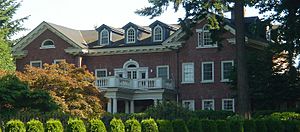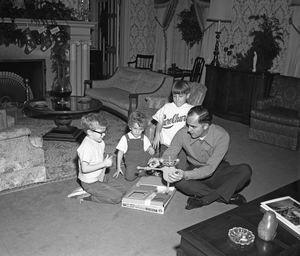Washington Governor's Mansion facts for kids
The Washington Governor's Mansion is where the governor of Washington lives and works. It's a beautiful building designed in the Georgian style, located on the grounds of the State Capitol campus in Olympia, the state capital. From its spot on Capitol Point, you can see mountains, Capitol Lake, and the city.
Quick facts for kids Washington Governor's Mansion |
|
|---|---|

Exterior of the mansion
|
|
| Location | Olympia, Washington, US |
| Built | 1908–1909 |
| Architect | Everett Phipps Babcock and Ambrose J. Russell |
| Architectural style(s) | Georgian Revival |
| Lua error in Module:Location_map at line 420: attempt to index field 'wikibase' (a nil value). | |
Contents
A Look Back at the Governor's Home
Building the Mansion
The Governor's Mansion was designed in 1908 by architects Russell and Babcock from Tacoma. It cost about $35,000 to build and has 19 rooms. Many important people attended the special ceremony when the first stone was laid.
The first governor to live in the mansion was Marion E. Hay in 1909. He became governor after Samuel G. Cosgrove became ill shortly after taking office. Since then, all governors and their families have lived in this official home.
Early Years and Changes
Governor Hay's wife, Elizabeth, bought many of the first furnishings for the mansion. Some of these original pieces, like a large mahogany buffet and a grandfather clock, are still there today.
In 1915, Governor Ernest Lister and his family moved out because they felt it was too expensive to keep the house warm in winter. Over time, electricity replaced gas lighting. In the 1950s, the building was updated to help keep the heat in. However, problems like roof leaks and noisy radiators continued.
Saving the Mansion
In the 1950s and 1960s, some lawmakers thought about tearing down the mansion. They wanted to build a new office building on the valuable land where it stood.
However, when Governor Daniel J. Evans and his family moved in during 1965, his wife, Nancy Evans, became a strong supporter of saving and fixing up the mansion. In 1972, she started a group called the Foundation for the Preservation of the Governor's Mansion. This group helped raise money and support for renovations. In 1973, the state government provided $600,000 to remodel and update the mansion.
Modern Challenges
In 1997, Governor Gary Locke and his family had an unusual problem: a colony of bats living in the mansion! The family even had to move out for a while so experts could deal with the bats.
A few years later, in 2001, the mansion was damaged by the Nisqually earthquake. It was repaired and made safe again.
More recently, in 2021, a group of people tried to enter the mansion grounds. The Washington State Patrol quickly removed them, and Governor Jay Inslee was taken to a safe room inside the mansion.
Inside the Governor's Mansion
The mansion has many beautiful rooms filled with historical art and furnishings.
Great Hall
- You'll see two large tables from the early 1800s, possibly made by Charles Lannuier of New York City. Mirrors above them were a gift from the people of Clallam County, Washington.
- There are also eight chairs covered in gold silk, with special "claw feet" and carved legs.
- A beautiful server made of mahogany and maple from around 1800 is also displayed.
Drawing Room
- This room features four pieces of furniture by a famous designer named Duncan Phyfe. These include two small tables, a sofa with carved details, and a piano.
- Above the piano is a "Constitution mirror" from around 1800, topped with an American eagle, a popular design from that time.
- You can also find a fine sewing stand with detailed carvings and other antique furniture like a black lacquer sofa.
Library
- Next to the Drawing Room is the Library. It has a round rosewood table and a sofa from the English Regency period. These were given in memory of Governor Samuel Cosgrove.
- The shelves are filled with books by Washington authors and books about the state's history.
State Dining Room
- The walls have special painted panels that show scenes from early state history. These are similar to murals found in the White House.
- The 18 dining room chairs have unique needlepoint covers made by volunteers in 1975.
- The mansion has many sets of beautiful dishes. One set is bone china with gold borders and the state seal (which shows George Washington). Another set is "Tuxedo" china, also with the state seal.
- There's also a special 27-piece sterling silver service. The silver and gold used to make it came from mines in Washington. It features oak leaves and acorns, and medallions representing the Navy and the state seal.
- This silver service was originally given to the Navy cruiser USS Olympia (C-6) in 1899 to celebrate its victory in the Battle of Manila Bay. When the ship was no longer in service, the silver came back to Olympia and was given to the state for use in the mansion.


